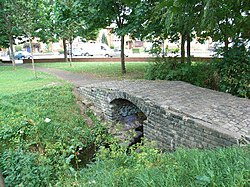Kimmage
| Kimmage Irish: Camaigh | |
| County Dublin | |
|---|---|
 The River Poddle in Kimmage | |
| Location | |
| Grid reference: | O141309 |
| Location: | 53°19’0"N, 6°17’20"W |
| Data | |
| Postcode: | D6, D12 |
| Local Government | |
| Council: | Dublin |
Kimmage is a suburb of Dublin, Ireland on the south side of the city.
The name 'Kimmage' is from the Irish Camaigh or Camaigh uisce, meaning 'crooked water-meadow', possibly referring to the meandering course of the River Poddle.
The village is to the south of Dublin city centre, outside the ring of canals, but before the M50 ring motorway or the Dublin Mountains. It is surrounded by Crumlin, Greenhills, Harold's Cross, Rathfarnham, Templeogue and Terenure.
The nearby River Poddle is a tributary of the River Liffey. It rises at Tymon west of central Tallaght then flows through Templeogue before reaching Kimmage and heading north to the city after dividing at Mount Argus. One stream, the City Watercourse, flows through the Donore Avenue and Blackpitts areas of south inner Dublin, while the main course flows via around Dublin Castle; the two merge in western Temple Bar and flow into the Liffey at Wellington Quay.
History
Larkfield, an old mill and farm in Kimmage owned by the family of Joseph Plunkett, was used as a clearing station for arms imported in the 1914 Howth gun-running for use in the 1916 Easter Rising.[1] An Irish Volunteers secret camp, the Kimmage Garrison, was established by Plunkett and his brother George Oliver Plunkett. Other members with engineering skills came from Great Britain and lived rough for three months while they manufactured bombs, bayonets and pikes for the coming Easter Rising on the site that is now the SuperValu shopping centre. From there they took a tram to the city centre to begin the uprising.
In the late 1940s and early 1950s, the park facing the end of Stannaway Road was known locally as the 'Tip'. The Tip had a water-filled quarry which froze over in the winter. In one tragic incident, three children drowned when they fell through thin ice and died.
The residential area between Ferns Road and Kildare Road was architecturally designed in the shape of a Celtic Cross, with a mirror image each side of Armagh Road. Locally this road was considered as dividing Crumlin and Kimmage. The majority of these roads were named after mediæval monasteries such as Clonmacnoise, Clonard, Kells and Monasterboice.
Sport
- Football: Larkview Boys FC
Popular culture
Kimmage was one of the two cheaper properties on the Irish version of Monopoly (along with Crumlin), but has now been removed in favour of Rathfarnham in the newer edition. Kimmage's working-class lifestyle is recorded in a popular Irish folk song of the same name, covered by the Dubliners.
Whoredom in Kimmage is a non-fiction 1994 book by Rosemary Mahoney about women in the Ireland of the 1990s.